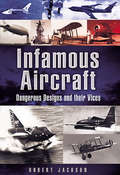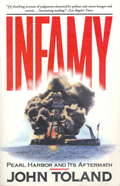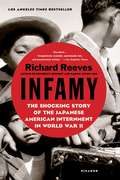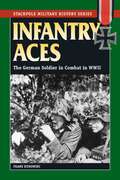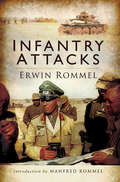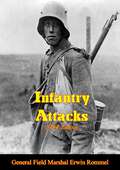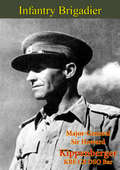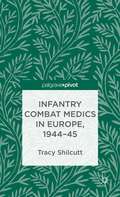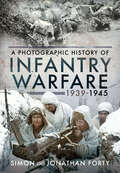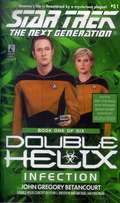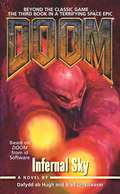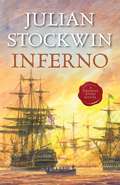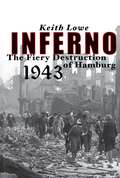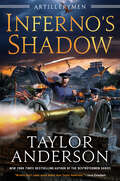- Table View
- List View
Infamous Aircraft: Dangerous designs and their vices
by Robert JacksonMany aircraft, some famous and some rare, gained a reputation for being difficult to fly and sometimes downright dangerous. This book looks at some of the worst culprits over a period spanning World War One to the age of supersonic flight. The following aircraft are included.BE.2—The RFC went to war in it in 1914. The BE was easy to fly and very stable—but it was difficult to maneuver and very easy to shoot down. Tarrant Tabor—The Tabor was grotesque, a massive misfit of an experimental bomber that predictably came to grief on its first flight. Avro Manchester—The twin-engined Manchester would fly all the way to Berlin and back—only to burst into flames over its own base. Messerschmitt Me 210—The Me 210 was developed as a successor to Goering's Destroyer, the Bf110. It was a disaster with a phenomenal accident rate. Martin B-26 Marauder—They called the B-26 the Widow-maker, fast and powerful, with some savage characteristics. Reichenberg IV—a manned version of the V-1 flying bomb, was a desperation weapon, its pilots intended to fly suicide missions against Allied shipping. Tu-144—Rushed prematurely into its test program to beat the Anglo-French Concorde, the TU-144 was intended to be Russia's supersonic dream.
Infamy
by John TolandBestselling author and historian John Toland's expertise and skill as a narrator were awarded with the Pulitzer Prize for his sweeping Rising Sun. In Infamy, Toland extends and corrects his account of the events leading up to Japan's attack on Pearl Harbor, addressing persistent questions: Could FDR have engineered a conspiracy to get the US into the War? Did high-level military and civilian leaders lie under oath? Were the wrong men held culpable in order to protect Washington? Accessing formerly secret government, military, and diplomatic records--including the account of the then anonymous and controversial "Seaman Z"--Toland masterfully reevaluates what we know about this infamous act of aggression against the US.
Infamy: The Shocking Story of the Japanese-American Internment in World War II
by Richard ReevesLess than three months after Japan bombed Pearl Harbor and inflamed the nation, President Roosevelt signed an executive order declaring parts of four western states to be a war zone operating under military rule. The U.S. Army immediately began rounding up thousands of Japanese-Americans, sometimes giving them less than 24 hours to vacate their houses and farms. For the rest of the war, these victims of war hysteria were imprisoned in primitive camps. In Infamy, the story of this appalling chapter in American history is told more powerfully than ever before. Acclaimed historian Richard Reeves has interviewed survivors, read numerous private letters and memoirs, and combed through archives to deliver a sweeping narrative of this atrocity. Men we usually consider heroes-FDR, Earl Warren, Edward R. Murrow-were in this case villains, but we also learn of many Americans who took great risks to defend the rights of the internees. Most especially, we hear the poignant stories of those who spent years in "war relocation camps," many of whom suffered this terrible injustice with remarkable grace. Racism, greed, xenophobia, and a thirst for revenge: a dark strand in the American character underlies this story of one of the most shameful episodes in our history. But by recovering the past, Infamy has given voice to those who ultimately helped the nation better understand the true meaning of patriotism.
Infantry Aces: The German Soldier in Combat in WWII (Stackpole Military History Series)
by Franz KurowskiCombat stories of eight German infantry soldiers: one paratrooper, two members of the Waffen-SS, and five members of the Wehrmacht. A concluding chapter examines infantry tactics.
Infantry Attacks
by Erwin RommelLegendary German general Erwin Rommel analyzes the tactics that led to his success. Field Marshal Erwin Rommel exerted an almost hypnotic influence not only over his own troops but also over the Allied soldiers of the Eighth Army in the Second World War. Even when the legend surrounding his invincibility was overturned at El Alamein, the aura surrounding Rommel himself remained unsullied. In this classic study of the art of war Rommel analyses the tactics that lay behind his success. First published in 1937 it quickly became a highly regarded military textbook, and also brought its author to the attention of Adolph Hitler. Rommel was to subsequently advance through the ranks to the high command in the Second World War. As a leader of a small unit in the First World War, he proved himself an aggressive and versatile commander with a reputation for using the battleground terrain to his own advantage, for gathering intelligence, and for seeking out and exploiting enemy weaknesses. Rommel graphically describes his own achievements, and those of his units, in the swift-moving battles on the Western Front, in the ensuing trench warfare, in the 1917 campaign in Romania, and in the pursuit across the Tagliamento and Piave rivers. This classic account seeks out the basis of his astonishing leadership skills, providing an indispensable guide to the art of war.
Infantry Attacks (Zenith Military Classics Ser.)
by Erwin RommelField Marshal Erwin Rommel exerted an almost hypnotic influence not only over his own troops but also over the Allied soldiers of the Eighth Army in the Second World War. Even when the legend surrounding his invincibility was overturned at El Alamein, the aura surrounding Rommel himself remained unsullied. In this classic study of the art of war Rommel analyses the tactics that lay behind his success. First published in 1937 it quickly became a highly regarded military textbook, and also brought its author to the attention of Adolph Hitler. Rommel was to subsequently advance through the ranks to the high command in the Second World War. As a leader of a small unit in the First World War, he proved himself an aggressive and versatile commander, with a reputation for using the battleground terrain to his own advantage, for gathering intelligence, and for seeking out and exploiting enemy weaknesses. Rommel graphically describes his own achievements, and those of his units, in the swift-moving battles on the Western Front, in the ensuing trench warfare, in the 1917 campaign in Romania, and in the pursuit across the Tagliamento and Piave rivers.This classic account seeks out the basis of his astonishing leadership skills, providing an indispensable guide to the art of war written by one of its greatest exponents.
Infantry Attacks [1944 Edition]
by General Field Marshal Erwin RommelInfantry Attacks is a classic text in the field of military strategy. Written by German Field Marshal Erwin Rommel, it was first published in 1937 as a journal-esque chronicle of the author's experiences in World War I and the lessons he learned there. In it, he provides detailed accounts of a variety of military strategies that rely on speed, deception, and deep penetration into enemy territory to intimidate and surprise opposing forces. Considered by his troops and enemies alike to be a humane, professional and immensely skilled officer, Rommel's use of intimidation and the advantage of surprise often forced enemies to surrender quickly, thereby avoiding unnecessary risk of injury and death for his troops (and their enemies), exertion, and expenditure of ammunition.Infantry Attacks was widely read by soldiers and military leaders upon its release and has become something of a staple in military education, providing a detailed glimpse into the tactics of an extremely effective and widely respected officer. It has been studied extensively throughout the West, particularly in the United States. The revered General George S. Patton is said to have been heavily influenced by this text.Rommel was appointed to the rank of high commander by Adolf Hitler in part because of the success of this book. Such positions were ordinarily reserved for members of old military families and the Prussian aristocracy, so this assignment spoke to Rommel's competence and the influence of his writing. Rommel went on to lead Hitler's Afrika Korps in North Africa. Although he planned to release a sequel based on his experiences there, he was unable to complete the manuscript before his death in 1944.-Print ed.
Infantry Brigadier
by Major-General Sir Howard Kippenberger KBE CB DSO & BarContains numerous Illustrations and MapsMajor-General Howard “Kip” Kippenberger still stands as one of the most famous soldiers ever produced by New Zealand. He saw the brutal slaughter of the First World War as an officer of the NZEF before being seriously wounded in 1916. Following the outbreak of the Second World War, “Kip” was appointed commander of the 20th Battalion of the newly re-constituted New Zealand Forces. He led his Kiwis with distinction in Greece and Crete, before promotion to Brigadier of the 5th Brigade, which fought in the desert during the North African Campaign. In the difficult campaigning in the mountains of Italy, Kippenberger was an inspirational leader and pushed his men forward in command of an entire Division. However his luck couldn’t hold as he stepped on a landmine near Monte Cassino, despite the amputation of his two feet he remained with his men until the last of his men were returned to New Zealand.“His own autobiographical account of his war, Infantry Brigadier, first appeared in 1949 and was acclaimed a classic in its field. Unit and campaign histories indicate how high were the standards he demanded of the authors. Taken together, they constitute a formidable achievement and will remain a monument to a man who inspired great efforts in soldiers and writers alike.”—Professor Angus Ross
Infantry Combat
by John AntalYou are the neophyte platoon leader in this informative and entertaining, interactive work from the author of Armor Attacks.
Infantry Combat Medics in Europe, 1944–45
by Tracy ShilcuttMedics learned quickly to ignore standing operating procedures in order to save, lives but tensions within infantry units created a paradoxical culture of isolation and acceptance. This groundbreaking work examines training and combat experiences of soldiers working in Battalion Aid Stations and those who went as aid men to the line companies.
Infantry Small Arms of the 21st Century: Guns of the World's Armies
by Leigh NevilleThe author of Guns of the Special Forces 2001-2015 presents a comprehensive overview of 21st century military guns used by small armies around the world. Soldiers in today's modern armies have access to ever more advanced infantry weapons; lighter, more compact and more accurate than anything seen in the last century. These include combat pistols, personal assault rifles, submachine guns, sniper rifles, shotguns, light machine guns and squad automatic weapons. Infantry Small Arms of the 21st Century features all these weapons and more, examining each in exhaustive detail. The author draws on the operational combat experience of the users in war zones such as Iraq, Afghanistan and Ukraine. As well as assessing and comparing the potency of different nations weapon systems, the book looks to the future demands of the infantry man.
Infantry Small Arms of the 21st Century: Guns of the World's Armies
by Leigh NevilleThe author of Guns of the Special Forces 2001-2015 presents a comprehensive overview of 21st century military guns used by small armies around the world. Soldiers in today's modern armies have access to ever more advanced infantry weapons; lighter, more compact and more accurate than anything seen in the last century. These include combat pistols, personal assault rifles, submachine guns, sniper rifles, shotguns, light machine guns and squad automatic weapons. Infantry Small Arms of the 21st Century features all these weapons and more, examining each in exhaustive detail. The author draws on the operational combat experience of the users in war zones such as Iraq, Afghanistan and Ukraine. As well as assessing and comparing the potency of different nations weapon systems, the book looks to the future demands of the infantry man.
Infantry Warfare, 1939–1945: A Photographic History
by Simon Forty Jonathan FortyThe infantry can always be found at the sharp end of the battlefield. You may be able to crush an opponent with armour or artillery, but there’s only one way to take and hold ground and that’s with riflemen – the ‘poor bloody infantry’. And it is the infantrymen of the Second World War – from all sides, Allied and Axis – who are the subject of this highly illustrated history. It uses over 400 wartime photographs plus contemporary documents and other illustrations to show the developments in equipment, training and tactical techniques and to give an insight into the experience of the infantry soldier during the conflict. Although the infantry were critical to the war effort, their contribution is often overshadowed by the more dramatic roles played by soldiers with more specialized skills – like tank crew, paratroopers and special forces. They also suffered devastating casualties, in particular during the last phase of the war in the west when around 20 per cent of an infantry division’s riflemen were likely to die and over 60 per cent could expect to be wounded. So as well as describing how the infantry fought, the authors look at the motivation which kept them fighting in awful conditions and despite brutal setbacks. The result is a thorough, detailed and revealing portrait of infantry warfare over seventy years ago.
Infection: Double Helix : #1 (Star Trek: The Next Generation #51)
by John Gregory BetancourtA Star Trek adventure set during The Original Series era from bestselling author John Gregory Betancourt!Like the twisted strands of mutant chromosomes, an insidious alien conspiracy winds its way through the entire Alpha Quadrant, just as it stretches across several years of Starfleet history—beginning near the very start of Captain Picard's command of the Starship Enterprise™! It is only the first year of the U.S.S. Enterprise™-D's ongoing mission when a virulent epidemic strikes the populace of Archaria III, endangering the lives of thousands and provoking acts of mob violence against those believed responsible for the spread of the disease. While Data and Natasha Yar team up to uncover the true origins of the virus, Dr. Crusher finds that the implacable sickness resists all her efforts to find a cure. The desperate quest for a cure becomes even more urgent when Deanna Troi succumbs to the dreaded plague...again and again.
Infernal Sky (Doom #3)
by Brad Linaweaver Dafydd ab HughHawaii-- last outpost of civilization on an Earth overrun by demons, traitors. and nightmarish creatures straight out of the pits of hell. Humanity seems doomed to a bloody ending. Then Hawaii receives a message from aliens claiming to be on our side in the battle. Our last chance: make contact. The only man for the job-- Corporal Flynn Taggart, U.S. Marine Corps-- "Fly" to his friends. He led the fight against the demon invaders when they swarmed through the Gates at Phobos Base. Now Fly's got to face the toughest task of his dirty career. Return to Phobos-- and fight his way past those demons to contact mankind's would-be rescuers...
Inferno
by Julian StockwinIn the 17th volume in the popular high-seas nautical adventure series, it is 1807 and Captain Sir Thomas Kydd's famous sea action aboard Tyger has snatched his reputation from ignominy. He is the hero of the hour. But although the British Navy remains imperious, a succession of battles has seen Napoleon victorious on mainland Europe. His enemies have sued for peace and the emperor&’s Continental System, establishing a European blockade, will leave Britain cut off from her economic lifeblood.One small link in this ring of steel is still free of French control: the neutral state of Denmark, which controls the straits through which the entire Baltic trade passes. In an attempt to prevent the French from taking control of Denmark's navy, Kydd's great friend Nicholas Renzi – now the Lord Farndon – is sent on a desperate diplomatic mission to persuade the Danes to give up their fleet to Britain. But the Danes are caught between two implacable forces and will not yield, opting instead for the inferno of battle.
Inferno
by Keith LoweIn the summer of 1943, British and American bombers launched an attack on the German city of Hamburg that was unlike anything the world had ever seen. For ten days they pounded the city with over 9,000 tons of bombs, with the intention of erasing it entirely from the map. The fires they created were so huge they burned for a month and were visible for 200 miles. The people of Hamburg had no time to understand what had hit them. As they emerged from their ruined cellars and air raid shelters, they were confronted with a unique vision of hell: a sea of flame that stretched to the horizon, the burned-out husks of fire engines that had tried to rescue them, roads that had become flaming rivers of melted tarmac. Even the canals were on fire. Worse still, they had to battle hurricane-force winds to escape the blaze. The only safe places were the city's parks, but to reach them survivors had to stumble through temperatures of up to 800°C and a blizzard of sparks strong enough to lift grown men off their feet. Inferno is the culmination of several years of research and the first comprehensive account of the Hamburg firestorm to be published in almost thirty years. Keith Lowe has interviewed eyewitnesses in Britain, Germany, and America, and gathered together hundreds of letters, diaries, firsthand accounts, and documents. His book gives the human side of an inhuman story: the long, tense buildup to the Allied attack; the unparalleled horror of the firestorm itself; and the terrible aftermath. The result is an epic story of devastation and survival, and a much-needed reminder of the human face of war. Includes nineteen maps and thirty-one photographs, many never seen before
Inferno's Shadow (Artillerymen)
by Taylor AndersonLost in a mysterious world, far from all they knew in 1847 America, Colonel Lewis Cayce and his soldiers must face the unimaginable might of the Dominion once and for all in this gripping alternate history from the New York Times bestselling author of the Destroyermen series.Colonel Lewis Cayce and his forces were a group of American soldiers bound to fight in the Mexican-American War—until they were stranded in a strange new world inhabited by vicious monsters, new friends, and deadly foes. Now Cayce has brought his army of displaced Americans and their indigenous allies into the heart of the loathsome, blood-drenched Dominion&’s stronghold. If he can take the enemy&’s holiest city and support the elevation of a new &“Supreme Holiness&” who seeks to moderate the Dominion&’s thirst for expansion, slavery, and blood sacrifice, Cayce&’s own goal for his army and new people to live in security and freedom will be assured.But no matter how good of a soldier he is, Cayce is ruled by reason, and the madness and seemingly suicidal treachery of his adversaries, not to mention the sheer titanic scope of the force arrayed against him, might finally be more than he can cope with. Which side will ultimately discover that even victory can end in defeat?
Inferno: The Fiery Destruction of Hamburg 1943
by Keith LoweIn the summer of 1943, British and American bombers launched an attack on the German city of Hamburg that was unlike anything the world had ever seen. For ten days they pounded the city with over 9,000 tons of bombs, with the intention of erasing it entirely from the map. The fires they created were so huge they burned for a month and were visible for 200 miles. The people of Hamburg had no time to understand what had hit them. As they emerged from their ruined cellars and air raid shelters, they were confronted with a unique vision of hell: a sea of flame that stretched to the horizon, the burned-out husks of fire engines that had tried to rescue them, roads that had become flaming rivers of melted tarmac. Even the canals were on fire. Worse still, they had to battle hurricane-force winds to escape the blaze. The only safe places were the city's parks, but to reach them survivors had to stumble through temperatures of up to 800°C and a blizzard of sparks strong enough to lift grown men off their feet. Inferno is the culmination of several years of research and the first comprehensive account of the Hamburg firestorm to be published in almost thirty years. Keith Lowe has interviewed eyewitnesses in Britain, Germany, and America, and gathered together hundreds of letters, diaries, firsthand accounts, and documents. His book gives the human side of an inhuman story: the long, tense buildup to the Allied attack; the unparalleled horror of the firestorm itself; and the terrible aftermath. The result is an epic story of devastation and survival, and a much-needed reminder of the human face of war.
Inferno: The Fire Bombing of Japan, March 9 - August 15, 1945
by Edwin P. HoytDid the bombing of Japan's cities—culminating in the nuclear destruction of Hiroshima and Nagasaki—hasten the end of World War II? Edwin Hoyt, World War II scholar and author, argues against the U. S. justification of the bombing. In his new book, Inferno, Hoyt shows how the U. S. bombed without discrimination, hurting Japanese civilians far more than the Japanese military. Hoyt accuses Major General Curtis LeMay, the Air Force leader who helped plan the destruction of Dresden, of committing a war crime through his plan to burn Japan's major cities to the ground. The firebombing raids conducted by LeMay's squadrons caused far more death than the two atomic blasts. Throughout cities built largely from wood, incendiary bombs started raging fires that consumed houses and killed hundreds of thousands of men, women and children. The survivors of the raids recount their stories in Inferno, remembering their terror as they fled to shelter through burning cities, escaping smoke, panicked crowds, and collapsing buildings. Hoyt's descriptions of the widespread death and destruction of Japan depicts a war machine operating without restraint. Inferno offers a provocative look at what may have been America's most brutal policy during the years of World War II.
Inferno: The Firebombing of Japan, March 9–August 15, 1945 (Lyons Press Library of WWII)
by Edwin P. HoytDid the bombing of Japan's cities—culminating in the nuclear destruction of Hiroshima and Nagasaki—hasten the end of World War II? Edwin Hoyt, World War II scholar and author, argues against the U.S. justification of the bombing. In Inferno, Hoyt shows how the United States bombed without discrimination, hurting Japanese civilians far more than the Japanese military. Hoyt accuses Major General Curtis LeMay, the Air Force leader who helped plan the destruction of Dresden, of committing a war crime through his plan to burn Japan's major cities to the ground. The firebombing raids conducted by LeMay's squadrons caused far more death than the two atomic blasts. Throughout cities built largely from wood, incendiary bombs started raging fires that consumed houses and killed hundreds of thousands of men, women, and children. The survivors of the raids recount their stories in Inferno, remembering their terror as they fled to shelter through burning cities, escaping smoke, panicked crowds, and collapsing buildings.Hoyt's descriptions of the widespread death and destruction of Japan depicts a war machine operating without restraint. Inferno offers a provocative look at what may have been America's most brutal policy during the years of World War II.
Inferno: The True Story of a B-17 Gunner's Heroism and the Bloodiest Military Campaign in Aviation History
by Joe PappalardoJoe Pappalardo's Inferno tells the true story of the men who flew the deadliest missions of World War II, and an unlikely hero who received the Medal of Honor in the midst of the bloodiest military campaign in aviation history.There’s no higher accolade in the U.S. military than the Medal of Honor, and 472 people received it for their action during World War II. But only one was demoted right after: Maynard Harrison Smith.Smith is one of the most unlikely heroes of the war, where he served in B-17s during the early days of the bombing of France and Germany from England. From his juvenile delinquent past in Michigan, through the war and during the decades after, Smith’s life seemed to be a series of very public missteps. The other airmen took to calling the 5-foot, 5-inch airman “Snuffy” after an unappealing movie character.This is also the man who, on a tragically mishandled mission over France on May 1, 1943, single-handedly saved the crewmen in his stricken B-17. With every other gunner injured or bailed out, Smith stood alone in the fuselage of a shattered, nameless bomber and fought fires, treated wounded crew and fought off fighters. His ordeal is part of a forgotten mission that aircrews came to call the May Day Massacre. The skies over Europe in 1943 were a charnel house for U.S. pilots, who were being led by tacticians surprised by the brutal effectiveness of German defenses. By May 1943 the combat losses among bomb crews were a staggering 40 to 50 percent.The backdrop of Smith’s story intersects with some of the luminaries of aviation history, including Curtis Lemay, Ira Eaker and “Hap” Arnold, during critical times of their storied careers. Inferno also examines Smith’s life in a new, comprehensive light, through the use of exclusive interviews of those who knew him (including fellow MOH recipients and family) as well as public and archival records. This is both a thrilling and horrifying story of the air war over Europe during WWII and a fascinating look at one of America's forgotten heroes.
Infidelities: Stories of War and Lust
by Josip NovakovichTragicomedy of the highest order, this stellar collection is Croatian writer Novakovich's best ever. Hailed as one of the best short story writers of the 1990s, Josip Novakovich was praised by the New York Times for writing fiction that has "the crackle of authenticity, like the bite of breaking glass." In his new collection, he explores a war–torn Balkan world in which a schoolchild's innocence evaporates in a puff of cannon smoke, lust replaces love, and the joy of survival overrides all other pleasures. As Serb, Croat, and Bosnian Muslim armies clash in the cities and countryside of the former Yugoslavia, it's hard to tell the front lines from the home front. The characters in Infidelities––soldiers and civilians alike––are caught in the ridiculous, often cruelly whimsical contradictions of war and the paranoia and folly of those who conduct it. In "Ribs," a Croatian woman whose husband has already been taken by the war will go to any length to keep her son out of the army, including sleeping with the draft officer, a tryst that leads to an unexpected, and disturbing, spiritual vision. A Buddhist soldier in the Bosnian Muslim military isly accused of being an informer to the enemy Serbs after his detachment ambushes itself in "Hail." A draft dodger is in the hospital for a transplant, in "A Purple Heart," when a high–ranking Croatian general steals the heart for himself (and dies) while the dodger suddenly discovers a new thirst for life. In "Spleen," a Bosnian émigré in America learns that even in the throes of passion she cannot find release from the haunting memories of her homeland. These stories cover a broad sweep of time, reaching back to the first shots of World War I in Sarajevo and forward to the plight of Balkan immigrants in contemporary America. Throughout, acts of compassion, gallows humour, even desire arise from a landscape devastated by tragedy.
Infiltration
by Don PendletonWith bloodied hands in everything from child porn to identity theft and spam scams, an elusive Russian cybercrime organization is poised for the big score. They've hacked into Wall Street's financial systems with a big prize at stake. Called upon for a blitz, Mack Bolan takes the network's top hacker into custody. Using the tech wizard to help him infiltrate the group's Manhattan ranks, Bolan poses as a gun for hire. Battered by intelligence leaks and enemy fire from New York to Boston, Bolan stays in grim pursuit. The complete destruction of the organization's infrastructure is priority one. If he stays lucky-and alive-Bolan will turn his sights on the scheme's mastermind. Nothing less than all-out war at the kingpin's Hamptons fortress and his Russian stronghold will deliver the justice Bolan demands for the victims of this ruthless enterprise.
Infiltrator: Infiltrator (Star Trek: The Next Generation #42)
by W.R. ThompsonIn this white-knuckled Star Trek: The Next Generation thriller, followers of the bloodthirsty tyrant Khan Noonien Singh bring the galaxy to the brink of another Eugenics War. Centuries ago, the brutal Khan Noonien Singh&’s remaining followers left Earth for the planet Hera to continue his experiments in selective breeding. Now, they are finally ready to launch their plan of universal domination—with the USS Enterprise as their weapon. Captain Picard must enlist the help of Heran expatriate Astrid Kemal to defeat her fellow superbeings. But unless the captain and crew of the Enterprise can stop them, the Heran infiltrators could alter the genetic landscape of the galaxy for generations to come.
